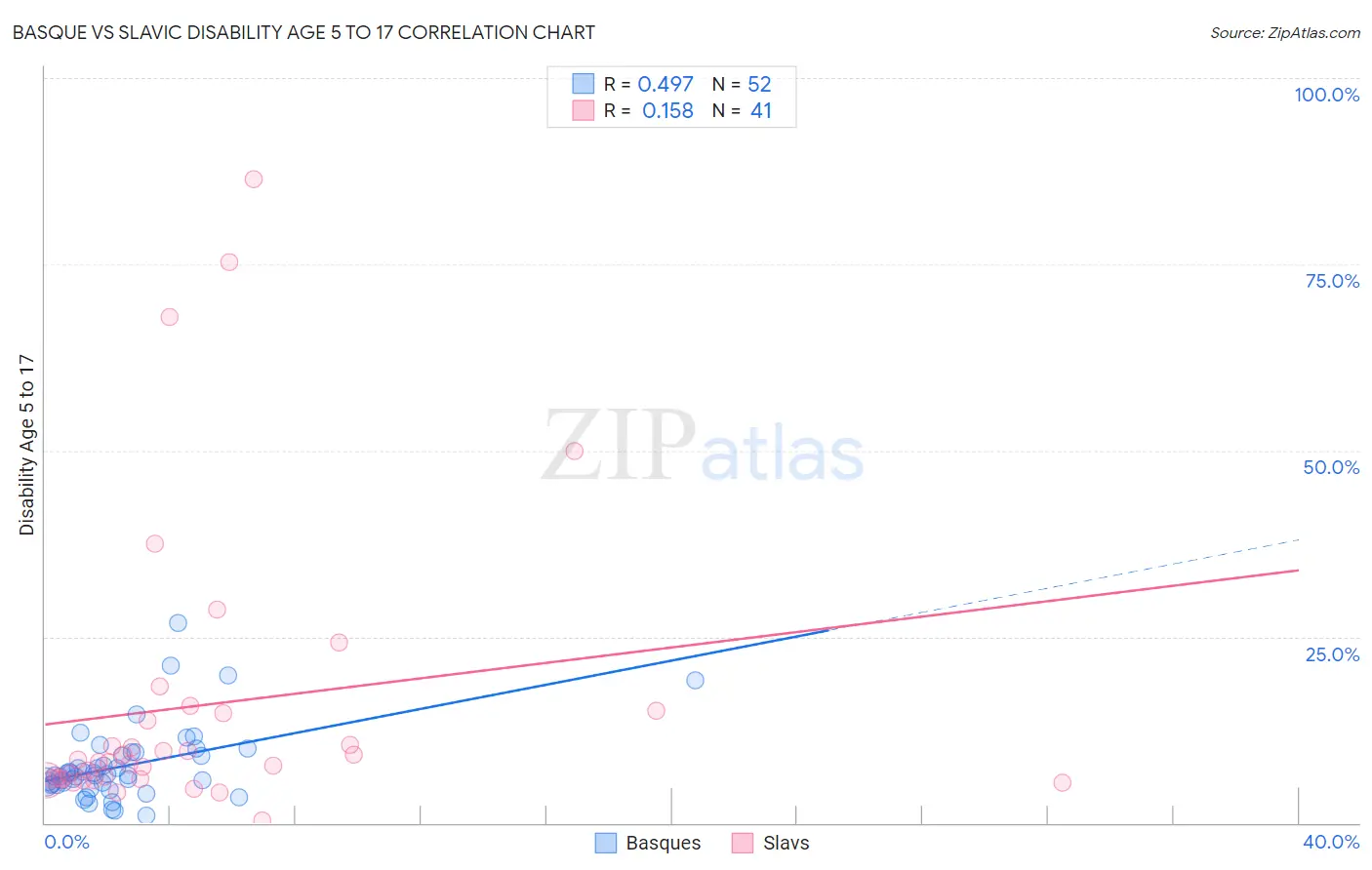Basque vs Slavic Disability Age 5 to 17
COMPARE
Basque
Slavic
Disability Age 5 to 17
Disability Age 5 to 17 Comparison
Basques
Slavs
5.7%
DISABILITY AGE 5 TO 17
13.7/ 100
METRIC RATING
201st/ 347
METRIC RANK
5.9%
DISABILITY AGE 5 TO 17
0.9/ 100
METRIC RATING
259th/ 347
METRIC RANK
Basque vs Slavic Disability Age 5 to 17 Correlation Chart
The statistical analysis conducted on geographies consisting of 165,145,807 people shows a moderate positive correlation between the proportion of Basques and percentage of population with a disability between the ages 5 and 17 in the United States with a correlation coefficient (R) of 0.497 and weighted average of 5.7%. Similarly, the statistical analysis conducted on geographies consisting of 269,139,689 people shows a poor positive correlation between the proportion of Slavs and percentage of population with a disability between the ages 5 and 17 in the United States with a correlation coefficient (R) of 0.158 and weighted average of 5.9%, a difference of 3.5%.

Disability Age 5 to 17 Correlation Summary
| Measurement | Basque | Slavic |
| Minimum | 0.97% | 0.37% |
| Maximum | 26.8% | 86.4% |
| Range | 25.9% | 86.0% |
| Mean | 7.7% | 15.8% |
| Median | 6.4% | 8.3% |
| Interquartile 25% (IQ1) | 5.2% | 5.9% |
| Interquartile 75% (IQ3) | 9.2% | 14.8% |
| Interquartile Range (IQR) | 4.0% | 8.9% |
| Standard Deviation (Sample) | 5.0% | 19.7% |
| Standard Deviation (Population) | 4.9% | 19.5% |
Similar Demographics by Disability Age 5 to 17
Demographics Similar to Basques by Disability Age 5 to 17
In terms of disability age 5 to 17, the demographic groups most similar to Basques are Austrian (5.7%, a difference of 0.050%), Icelander (5.7%, a difference of 0.090%), Spanish American Indian (5.7%, a difference of 0.090%), Northern European (5.7%, a difference of 0.15%), and Paiute (5.7%, a difference of 0.27%).
| Demographics | Rating | Rank | Disability Age 5 to 17 |
| Croatians | 23.6 /100 | #194 | Fair 5.7% |
| Immigrants | Nigeria | 23.4 /100 | #195 | Fair 5.7% |
| Inupiat | 23.3 /100 | #196 | Fair 5.7% |
| Immigrants | North America | 23.1 /100 | #197 | Fair 5.7% |
| Norwegians | 20.9 /100 | #198 | Fair 5.7% |
| Northern Europeans | 15.2 /100 | #199 | Poor 5.7% |
| Icelanders | 14.6 /100 | #200 | Poor 5.7% |
| Basques | 13.7 /100 | #201 | Poor 5.7% |
| Austrians | 13.2 /100 | #202 | Poor 5.7% |
| Spanish American Indians | 12.8 /100 | #203 | Poor 5.7% |
| Paiute | 11.2 /100 | #204 | Poor 5.7% |
| Trinidadians and Tobagonians | 10.8 /100 | #205 | Poor 5.7% |
| Immigrants | Africa | 10.8 /100 | #206 | Poor 5.7% |
| Moroccans | 10.4 /100 | #207 | Poor 5.7% |
| Kenyans | 10.0 /100 | #208 | Poor 5.8% |
Demographics Similar to Slavs by Disability Age 5 to 17
In terms of disability age 5 to 17, the demographic groups most similar to Slavs are Brazilian (5.9%, a difference of 0.060%), Hispanic or Latino (5.9%, a difference of 0.090%), Somali (5.9%, a difference of 0.13%), Hopi (5.9%, a difference of 0.18%), and Immigrants from Middle Africa (5.9%, a difference of 0.20%).
| Demographics | Rating | Rank | Disability Age 5 to 17 |
| Hondurans | 1.5 /100 | #252 | Tragic 5.9% |
| Scandinavians | 1.4 /100 | #253 | Tragic 5.9% |
| Barbadians | 1.3 /100 | #254 | Tragic 5.9% |
| Italians | 1.2 /100 | #255 | Tragic 5.9% |
| Hopi | 1.0 /100 | #256 | Tragic 5.9% |
| Hispanics or Latinos | 1.0 /100 | #257 | Tragic 5.9% |
| Brazilians | 0.9 /100 | #258 | Tragic 5.9% |
| Slavs | 0.9 /100 | #259 | Tragic 5.9% |
| Somalis | 0.8 /100 | #260 | Tragic 5.9% |
| Immigrants | Middle Africa | 0.7 /100 | #261 | Tragic 5.9% |
| Immigrants | Western Africa | 0.7 /100 | #262 | Tragic 5.9% |
| Czechoslovakians | 0.7 /100 | #263 | Tragic 5.9% |
| Canadians | 0.6 /100 | #264 | Tragic 6.0% |
| Panamanians | 0.6 /100 | #265 | Tragic 6.0% |
| Slovenes | 0.6 /100 | #266 | Tragic 6.0% |